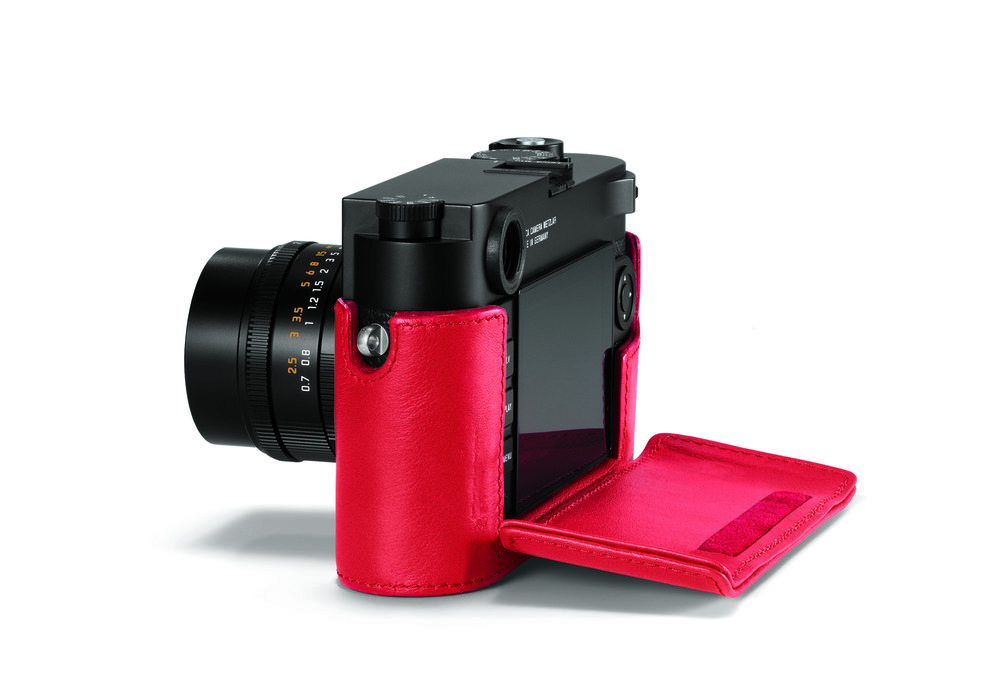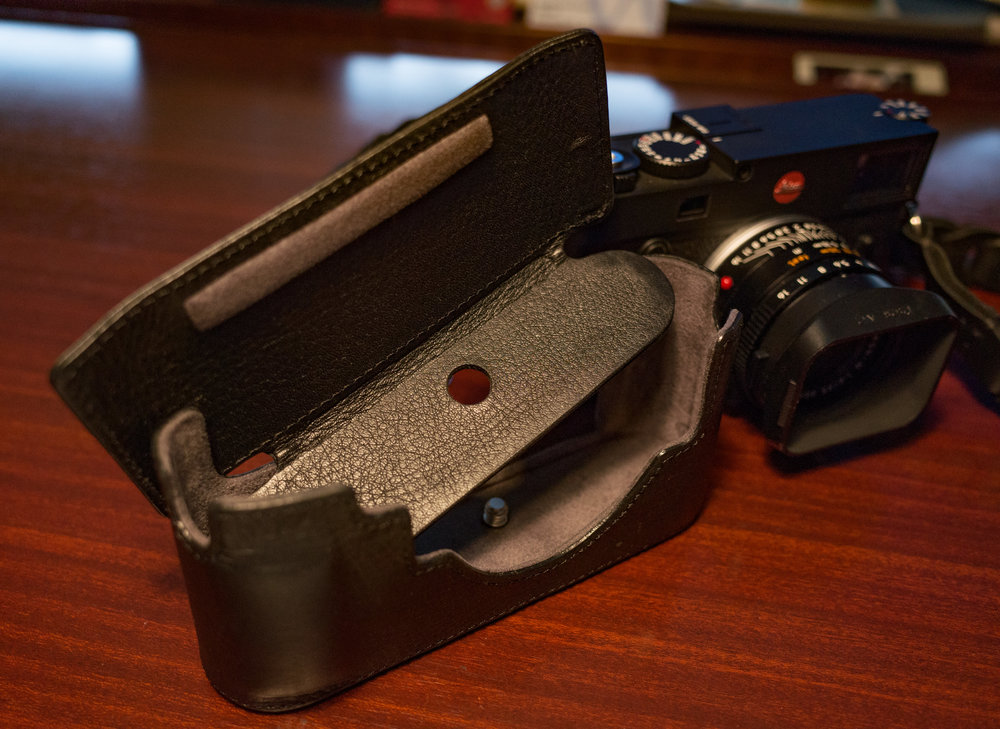The official Leica protector — or half case — for the new M10 shows a high degree of design ingenuity. I was immediately intrigued by the way in which the rear flap slots seamlessly inside the base of the case. This isn’t the first half-case with a removable back but as a design concept it is one of the best.
The protector case and the back cover are two separate units. The back has a tongue which slips inside the case and under the camera. It is thus firmly held in place and doesn’t need hinges or press-stud fixings. There is no doubting the neatness of this arrangement. The back is contoured to mould qirh the curves of the camera body and it clicks into place firmly. It is decidedly neat.
Above: A coin is needed to attach or remove the case (left). In the centre shot you see how the short case leaves the entire top-plate exposed. On the right, the case back fits by means of a leather tongue which sits under the camera. The case adds 10mm to the height of the M10 and this is not a welcome feature.
My main interest in the case — with the back protector in place — was to keep the screen away from chimping eyes and the fingers away from the buttons. The leather back gives the camera a tactile attractiveness that is missing on modern digitals with their plethora of buttons and dials. Since I go for the simple life, mainly employing aperture, speed and sensitivity, I have little reason to delve into the menus — even the excellent pruned-down favourites screen — so I am perfectly happy with the leather back in situ most of the time.
In some respects this reminds me of the Leica M-D which, of course, has no screen and almost no buttons. During my time with the M-D I realised that I didn’t miss all the adjustments and chimping abilities of modern cameras. It is possible to function perfectly well with a digital that thinks it is a film camera, at least in terms of controls and options.

The case itself fits snugly, a little on the tight side if anything, but this is something that will improve with use. The matte-finish leather is of high quality, whether you go for the black, red or tan versions, and the workmanship is exemplary. I cannot fault the case on either aspect. Underneath, in a nice touch: The bottom of the case is engraved with the Leica script logo.
In practical terms, the case falls down in not providing cover for the top edges of the camera top plate. The case is short, extending only to the top of the screen, thus leaving the top plate in its entirety unprotected. This is a worrying aspect. If you are going to have a case, it ought to offer as much protection as possible.

The case has been designed to work with the Leica thumb grip and this is one of the reasons it is so short. Some other manufacturers overcame this problem by offering cases with thumb-grip cut-outs. Leica has decided to go for simplicity and has assumed that most case buyers will also go for the thumb grip.
The lack of press-stud-closing ears at the top of the case means that the only way of securing the protector to the camera is by means of a screw in the case bottom. While this is the traditional approach, I prefer the currently more popular press-stud closure as used on the Classic Cases and Arte di Mano models I have reviewed. With the M10, though, there is a complication in the presence of the ISO dial which could make the top-flap fixing less effective and this could be a reason Leica’s designers chose this layout.
A screw fixing, while totally secure, requires a tool — usually a coin — to fasten and unfasten. It adds further delay and frustration to removing the case when seeking the SD card or battery. Since this is something you will probably have to do at least once a day, sometimes in less-than-ideal conditions, it is worth considering the downside.

The Leica protector has a small front grip, not much more than a bump, which does give some aid to gripping the camera. I think it adds to the handling and feels very comfortable in use. However, a little more bulk to the grip would be useful and would not detract from the appearance.
While I cannot fault the case on quality of leather and construction, I do have reservations about the the lack of protection for the corners of the top plate. This rather detracts from its practicality, I’m afraid.
In my view, though, the biggest problem with the Leica case is the height it adds to the camera. All cases add some height, usually about 5mm, and it is only to be expected. But this case, with its additional tongue of leather to attach the rear protector, adds a full 10mm to the camera height. Since the case itself is short, coming level with the base of the top plate, the whole creates a rather unbalanced aspect with the top a now tall camera peering out over the edge of the shortie case.
Despite the negative comments, I do like this case, particularly because of the well-engineered back flap and the way in which it moulds perfectly to the contours of the camera.
At £160 here in the UK it is not expensive, as cases go, and it complements the M10 as a smart accessory. Overall, though, my views are mixed.. I will be interested to see what our own British manufacturer, Paul Glendell makes of the M10 when he introduces his Classic Case. I shall also be looking at another of my favourite designers, Arte di Mano, who have already introduced an M10 case in their classic design with press-stud ear fixing. From the pictures, they seem to have coped with the presence of the ISO dial effectively.
________________





A bit of a contrasting opinion on the design here.
I have the Classic Cases half case for the M240. It’s wonderfully made and lovely, but even after some lengthy use it’s takes some time and effort to wrestle the camera out of it, generally because it’s a well shaped, snug fit. That’s one thing I don’t like about the designs with the studs up top.
It would seem to be that the Leica design, while requiring some kind of tool to loosen, would help separate the case from the camera by virtue of the screw pushing the camera up and out during the action of unscrewing it. It’s a process, yes, but with the other design I find I’m trying to find purchase on the small parts of the corners of the camera left exposed to free it, or wrenching it by the lens/mount instead, which I should probably avoid.
Thanks Mike!
Chris H
Hi Chris
Indeed, everything is a matter of choice. I too like Paul Glendell’s cases and they wear in really well. They’re what I can the traditional design, with stiffer leather, in contrast to the Leica case and many others )such as Arte di Mano which tend to be made from softer leather.
Mike
I hope you don’t take this the wrong way – but in light of your recent escapades, might need a little more padding…
Yes, sadly, something is needed.
Makes me think perhaps in the light of your recent fall, Mike, that a protector case for you might be a higher priority! Hope yu are improving.
Yes, as someone else suggested, a Leica Airbag might be a more practical accessory.
I might have to resort to carrying the camera in the manufacturer’s padded box, extracting it only at the decisive moment.
Interesting review Mike, but not something that I would wish for…
… I mean… Just about the most famous feature of the new M10, is its "thinckness"…
Feels just like an old film M….
Add one half case and voila, you now have an M-P 240!
Dear Pooper,
You are so right. Who needs a case when it makes the camera so much thicker. And without the case more brassing is possible. Nothing to dislike.
Thanks for great review!
How much does the back cover add the thickness actually? 3mm? 5mm?
Hi Satoshi
It adds about 3mm but the problem is that there is no height saving if you don’t use the back cover. Instead you have to fit the spacer under the camera to bring it up to the same height so the screen isn’t obstructed. I have mixed views on this case as you gather from the article. But it is undeniably well made and attractive.